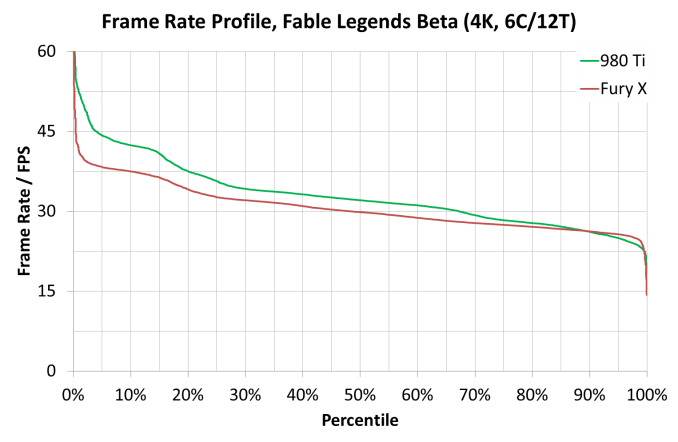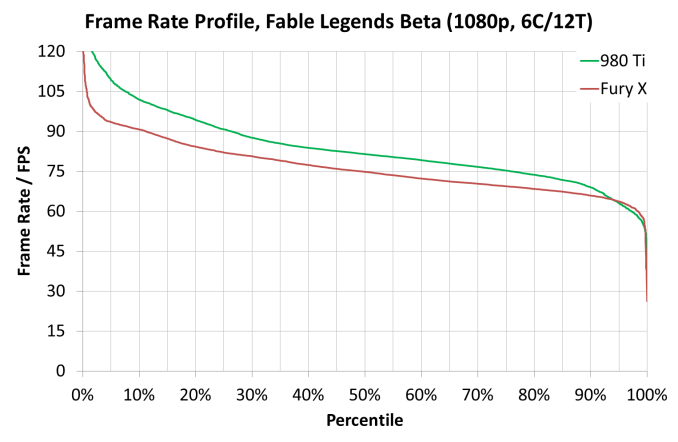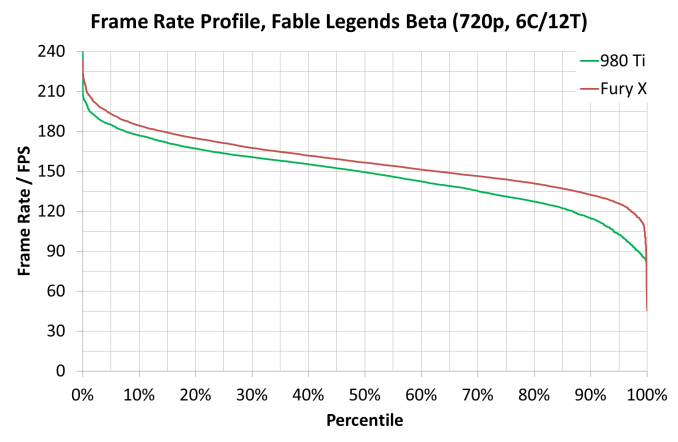Fable Legends Early Preview: DirectX 12 Benchmark Analysis
by Ryan Smith, Ian Cutress & Daniel Williams on September 24, 2015 9:00 AM ESTComparing Percentile Numbers Between the GTX 980 Ti and Fury X
As the two top end cards from both graphics silicon manufacturers were released this year, there was all a big buzz about which is best for what. Ryan’s extensive review of the Fury X put the two cards head to head on a variety of contests. For DirectX 12, the situation is a little less clear cut for a number of reasons – games are yet to mature, drivers are also still in the development stage, and both sides competing here are having to rethink their strategies when it comes to game engine integration and the benefits that might provide. Up until this point DX12 contests have either been synthetic or having some controversial issues. So for Fable Legends, we did some extra percentile based analysis for NVIDIA vs. AMD at the top end.
For this set of benchmarks we ran our 1080p Ultra test with any adaptive frame rate technology enabled and recorded the result:
For these tests, usual rules apply – GTX 980 and Fury X, in our Core i7/i5/i3 configurations at all three resolution/setting combinations (3840x2160 Ultra, 1920x1080 Ultra and 1280x720 Low). Data is given in the form of frame rate profile graphs, similar to those on the last page.
As always, Fable Legends is still in early access preview mode and these results may not be indicative of the final version, but at this point they still provide an interesting comparison.
At 3840x2160, both frame rate profiles from each card looks the same no matter the processor used (one could argue that the Fury X is mildly ahead on the i3 at low frame rates), but the 980 Ti has a consistent gap across most of the profile range.
At 1920x1080, the Core i7 model gives a healthy boost to the GTX 980 Ti in high frame rate scenarios, though this seems to be accompanied by an extended drop off region in high frame rate areas. It is also interesting that in the Core i3 mode, the Fury X results jump up and match the GTX 980 Ti almost across the entire range. This again points to some of the data we saw on the previous page – at 1080p somehow having fewer cores gave the results a boost due to lighting scenarios.
At 1280x720, as we saw in the initial GPU comparison page on average frame rates, the Fury X has the upper hand here in all system configurations. Two other obvious points are noticeable here – moving from the Core i5 to the Core i7, especially on the GTX 980 Ti, makes the easy frames go quicker and the harder frames take longer, but also when we move to the Core i3, performance across the board drops like a stone, indicating a CPU limited environment. This is despite the fact that with these cards, 1280x720 at low settings is unlikely to be used anyway.













141 Comments
View All Comments
piiman - Saturday, September 26, 2015 - link
"Yes, but when the goal is to show improvements in rendering performance"I'm completely confused with this "comparison"
How does this story even remotely show how will Dx12 works compared to Dx11? All they did was a Dx12 VIDEO card comparison? It tells us NOTHING in regard to how much faster Dx12 is compared to 11.
inighthawki - Saturday, September 26, 2015 - link
I guess what I mean is the purpose of a graphics benchmark is not to show real world game performance, it is to show the performance of the graphics API. This this case, the goal is trying to show that D3D12 works well. Throwing someone into a 64 player match of battlefield 4 to test a graphics benchmark defeats the purpose because you are introducing a bunch of overhead completely unrelated to graphics.figus77 - Monday, September 28, 2015 - link
You are wrong, many dx12 implementation will help on very chaotic situation with many pg and big use of IA, this benchmark is usefull like a 3dmark... just look at the images and say is a nice graphics (still Witcher3 in DX11 is far better for me)inighthawki - Tuesday, September 29, 2015 - link
I think you missed the point - I did not say it would not help, I just said that throwing on tons of extra overhead does not isolate the overhead improvements on the graphics runtime. You would get fairly unreliable results due to the massive variation caused by actual gameplay. When you do a benchmark of a specific thing - e.g. a graphics benchmark, which is what this is, then you want to perform as little non-graphics work as possible.mattevansc3 - Thursday, September 24, 2015 - link
Yes, the game built on AMD technology (Mantle) before being ported to DX12, sponsored by AMD, made in partnership with AMD and received development support from AMD is a more representative benchmark than a 3rd party game built on a hardware agnostic engine.YukaKun - Thursday, September 24, 2015 - link
Yeah, cause Unreal it's very neutral.Remember the "TWIMTBP" from 1999 to 2010 in every UE game? Don't think UE4 is a clean slate coding wise for AMD and nVidia. They will still favor nVidia re-using old code paths for them, so I'm pretty sure even if the guys developing Fable are neutral (or try to), UE underneath is not.
Cheers!
BillyONeal - Thursday, September 24, 2015 - link
That's because AMD's developer outreach was terrible at the time, not because Unreal did anything specific.Kutark - Monday, September 28, 2015 - link
Yes, but you have to remember, Nvidia is Satan, AMD is Jesus. Keep that in mind when you read comments like that and all will make senseStuka87 - Thursday, September 24, 2015 - link
nVidia is a primary sponsor of the Unreal Engine.RussianSensation - Thursday, September 24, 2015 - link
UE4 is not a brand agnostic engine. In fact, every benchmark you see on UE4 has GTX970 beating 290X.I have summarized the recent UE4 games where 970 beats 290X easily:
http://forums.anandtech.com/showpost.php?p=3772288...
In Fable Legends, a UE4 DX12 benchmark, a 925mhz HD7970 crushes the GTX960 by 32%, while an R9 290X beats GTX970 by 13%. Those are not normal results for UE4 games that have favoured NV's Maxwell architecture.
Furthermore, we are seeing AMD cards perform exceptionally well at lower resolutions, most likely because DX12 helped resolve their DX11 API draw-call bottleneck. This is a huge boon for GCN moving forward if more DX12 games come out.
Looking at other websites, a $280 R9 390 is on the heels of a $450 GTX980.
http://techreport.com/review/29090/fable-legends-d...
So really besides 980Ti (TechReport uses a heavily factory pre-overclocked Asus Strix 980TI that boosts to 1380mhz out of the box), the entire stack of NV's cards from $160-500 loses badly to GCN in terms of expected price/performance.
We should wait for the full game's release and give NV/AMD time to upgrade their drivers but thus far the performance in Ashes and Fable Legends is looking extremely strong for AMD's cards.